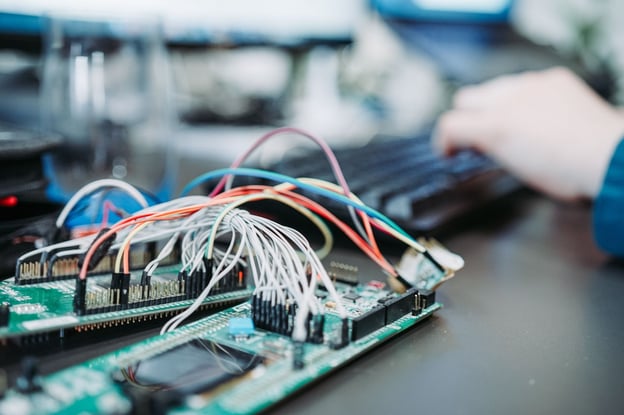4 IoT Device Security Best Practices for Every Organization

Modern network security is not just about securing computers, laptops, and smartphones. The various online-connected sensors and smart devices that make up the Internet of Things (IoT) also need protection —especially since over 90% of IoT traffic is unencrypted. Yet while these devices pose a risk, businesses can meet the challenge by applying the following best practices for IoT device security.
Jump to a section…
Implement IoT Device Security Gateways
Introduce Zero Trust Processes
Need to brush up on the fundamentals of IoT Security? Check out our complete guide to IoT Security, or visit our solutions page to learn how Byos can help.
Implement IoT Device Security Gateways
Perhaps the biggest challenge in IoT device security is managing the sheer volume of connected objects. For example, the average room in a modern hospital contains anywhere from 15-20 IoT devices. Meanwhile, operations in a smart factory typically require one connected device for every two meters of floor space. Each device is another endpoint that extends the IoT attack surface — and that’s before considering challenges like legacy device requirements, communication protocols and software vulnerabilities.
One of the most effective solutions is to deploy the IoT gateway, segmenting associated devices and reducing attack exposire to the rest of the network. Purpose-built IoT are already effective at streamlining data from multiple endpoints, but the real value is they let network managers manage and control traffic originating from IoT devices. Even if an IoT device is compromised, the gateway prevents unauthorized data from transmitting across the broader network. As a bonus, gateways often make IoT device management more efficient by providing accurate asset inventories and aggregating traffic across any number of unique devices.
Secure Devices Physically
One reason so many industries are turning to the Internet of Things is the opportunity for automation. In a smart building, humans don’t have to manually monitor each piece of equipment to confirm everything is in working order. In practice, this means sensors, cameras, and other connected devices are left in isolated locations where malicious actors can find them. This isolation is an inherent security risk — if someone cannot exploit an IoT device remotely, they may be able to approach it physically for an unsecured access point.
It’s vital to consider physical security measures at each IoT device location, particularly those relating to sensitive data. For example, is there a workstation where staff can monitor all IoT objects and visitors in the area? Are devices secured within a locked container, such as a camera dome? Sometimes the simplest physical barriers can effectively reduce attacks by discouraging opportunities for malicious parties to find manual exploits.
Back to topIntroduce Zero Trust Processes
With most IoT infrastructures, security teams balance a complex array of devices, communication protocols, and operating systems. In such an environment, it’s crucial to implement Zero Trust network techniques. This approach ensures that each access attempt is treated no differently on a secured network than an open network, minimizing the impact of an actual breach when it occurs.
It’s worth noting that Zero Trust solutions rarely apply to a single category of networked devices. Security specialists usually need to account for it within their architecture by explicitly verifying access for all users and devices on the network. Once this foundation is in place, it’s easier to implement the following Zero Trust IoT principles:
- Maintain accurate IoT devices inventories: IT teams should register every device on their network to verify their identities. Be sure to include renewable credentials, passwordless authentication, and a hardware root trust for additional IoT protection.
- Limit device communications: All IoT devices should have workload access controls in place to secure any communications between them. This process limits the impact of any security breaches to a relatively small radius.
- Streamline updating processes: Keeping software and operating systems up to date is vital to protect them from attacks — but updating dozens of IoT devices can be onerous and time-consuming. Whenever possible, implement centralized configuration and compliance solutions so IT specialists can update all devices the moment new patches become available.
- Implement active threat monitoring: Maintaining security for IoT devices is an ongoing process. Use automated systems to monitor active threats and suspicious activity to identify risks as quickly as possible.
Microsegment Your IoT Devices
It’s not unusual for organizations to have flat networks where IT networks are intertwined with IoT devices. However, in practice, that only increases the risk of malware infecting business-critical devices. Microsegmentation is a practical approach to provide security and segregation of IoT devices from IT networks, while maintaining control and visibility over them.
Microsegmentation divides a network into smaller “segments” to isolate endpoints from each other. This technique drastically reduces the available attack surface while increasing the defensibility of each segment — raising the overall security profile of the network in the process. If a malware or ransomware attack does compromise a particular device, the network’s overall integrity remains intact, unlike networks that use perimeter security as their main line of defense.
More importantly, microsegmentation benefits stack with other best practices described above. For example, security teams can use multiple IoT gateways to microsegment their network while maintaining remote control over each device. Meanwhile, whitelists and least privilege access controls can restrict communication between IoT devices, reducing the impacts of lateral movement.. These features make microsegmentation one of the most effective IoT device security techniques today.
Back to topSecure Your IoT Devices Today
Byos offers a microsegmentation solution for any high assurance use case: the Byos µGateway. The µGateway leverages edge microsegmentation and hardware-enforced isolation practices to help security teams detect, contain, and eliminate threats whenever a breach occurs. With features like secure remote access zero touch deployment, and legacy OS protection, the µGateway provides state-of-the-art IoT device security for your peace of mind.
Ready to learn more? Get in touch with us here.

